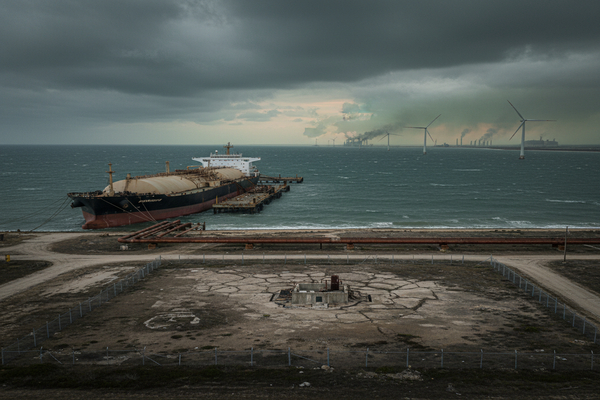
US LNG industry gets a black eye. An arbitration ruling that sided with BP (NYSE:BP) over delivery failures at Venture Global’s Calcasieu Pass plant has exposed contractual weak points. The decision matters now because it lands as Europe prepares for winter and as global gas flows are already under strain. In the short term buyers face legal reruns and disrupted supply contracts. In the long term investor confidence and project underwriting could be weakened. The case weighs on the United States, affects European buyers, alters Asian supply expectations, and adds to pressures in emerging markets that rely on LNG. The episode follows a period of breakneck US export growth that now risks contributing to a global supply glut.
Arbitration ruling and market consequences
BP won a court finding that Venture Global failed to declare commercial operations at Calcasieu Pass on time. The ruling says that allowed Venture Global to sell hundreds of LNG cargoes for more than three years before delivering on long term deals to buyers that included BP (NYSE:BP) and Shell (NYSE:SHEL). BP is seeking damages in excess of one billion dollars plus interest and legal costs. The legal result exposes a mismatch between project timelines and contract expectations.
For buyers the ruling is a short term vindication. Companies that committed to long term supply now have legal precedent to press claims when suppliers reassign cargoes. For suppliers the decision is a reputational setback. The US LNG sector expanded quickly, and that rapid growth now looks set to add to global oversupply risks. That dynamic can create price pressure across markets from Europe to Asia.
Investors and lenders may react by tightening scrutiny on future liquefaction projects. Contract terms, delivery guarantees and plant start up tests will come under closer review. Underwriters may demand clearer milestone provisions and penalties. That will raise the cost and complexity of bringing new US capacity online. Over time that could temper the breakneck expansion that helped make the United States a dominant exporter.
Security alarm in Europe
Europe faces a wave of suspected hybrid attacks that has governments on alert. The incidents include drone incursions, suspected navigation system jamming, cyberattacks and isolated sabotage. NATO members from Scandinavia to the Baltic states have reported multiple encounters since early September. Reports suggest some aircraft were launched from tankers off Europe’s coast.
So far the recent incidents have not directly struck the continent’s energy infrastructure. That system includes hundreds of thousands of kilometres of pipelines and power lines, as well as LNG terminals, offshore fields and renewables. However Ukraine and Russia have ratcheted up strikes on each other’s energy facilities. Ukrainian attacks on Russian refineries have curbed fuel output and exports. Russia has launched heavy strikes on Ukrainian gas production. Those actions increase the risk that energy assets could become deliberate targets elsewhere.
With winter approaching the timing matters. Europe’s supply and demand balance is fragile. Any disruption could lead to spot price spikes and higher consumer bills. Governments may now face pressure to boost protection measures, harden critical nodes and improve contingency planning. The immediate challenge is logistical. The strategic question is whether current planning matches the new threat environment.
Corporate agenda and policy signals
Industry leaders are gathering this week at the Energy Intelligence Forum in London. Chief executives from major oil and gas companies will address how producers respond to market and security risks. Exxon Mobil (NYSE:XOM), TotalEnergies (NYSE:TTE) and ConocoPhillips (NYSE:COP) are among those scheduled to speak. The meeting comes as three forces are reshaping market rhetoric: legal and contractual fallout from delayed US LNG projects, ongoing military conflict in Eastern Europe, and record flows from OPEC plus some members pumping more to meet near term demand.
Other headlines underline the mixed picture. Oil prices have recovered some ground after renewed US China trade pressure. OPEC has suggested a smaller supply gap for 2026 as producers maintain output. Countries in North Africa are signing large deals, such as Algeria’s $5.4 billion oil and gas agreement with Saudi firm Midad Energy. At the same time several firms are seeking fresh capital to scale green or upstream projects. Those moves matter because they feed into where investment flows and where supply will come from in the years ahead.
What this means for markets and risk managers
The arbitration and Europe security incidents are separate but related market shocks. The legal decision highlights contract risk in the surge of US LNG exports. The security incidents expose physical and cyber vulnerabilities in European energy systems. Together they raise the cost of doing business for providers and buyers. Traders may reprice contract risk premiums. Utilities and national buyers may demand tighter guarantees. Lenders and insurers may change terms on new projects.
For energy consumers in Asia and emerging markets the combined effect could be uneven supply and more volatile spot markets. In Europe the focus will be on winter readiness and on measures to protect critical pipelines and terminals. Governments may accelerate investments in redundancy, storage and alternative supply routes. For market participants the near term is about managing contract disputes and winter risk. The longer term picture concerns how fast new supply gets financed and how resilient infrastructure becomes.
The sector now faces both legal scrutiny and security threats. That dual pressure will inform boardroom decisions and investor assessments in the coming months. The next few weeks should reveal how quickly buyers pursue damages, how companies respond at industry forums, and how European authorities heighten protections ahead of winter.












